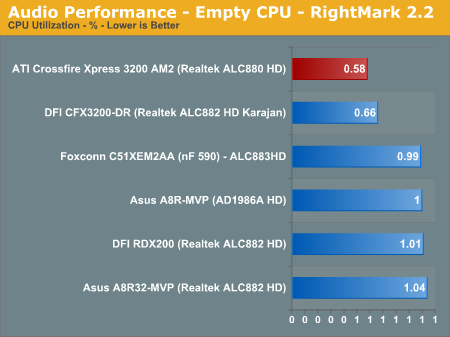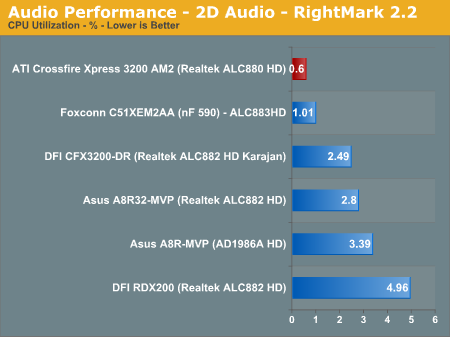CrossFire Xpress 3200: RD580 for AM2
by Wesley Fink on June 1, 2006 12:05 AM EST- Posted in
- Motherboards
Audio Performance
Audio testing used the latest version 2.2 of the Rightmark 3D Sound CPU utilization test. This benchmark measures the overhead or CPU utilization required by a codec or hardware audio chip. Versions earlier than 2.2 would not work properly on the RD580 chipset .



All benchmarks used Realtek Driver Version 1.36. CPU utilization across the board were the lowest we have ever measured with this utility, ranging from around 0.6% in Empty CPU and 2D tests to 1.4% in 3D and 3D+EAX tests. These utilization numbers are the result of the dual-core CPU as Realtek uses load sharing to drive the audio codec. Unfortunately, as we first described in Intel Core Duo: AOpen i975Xa-YDG to the Rescue, these low test results do not consistently translate into better FPS results in gaming. Results with HD audio on dual-core showed a similar loss of FPS whether run with a single or dual-core CPU.
Realtek has been very consistent in recent months in releasing regular updates to their HD audio drivers, and we suspect that trend will continue with ATI, Intel, and NVIDIA all now firmly committed to HD Azalia audio. Each new Realtek update has lowered CPU utilization and we also hope that will continue.
Audio testing used the latest version 2.2 of the Rightmark 3D Sound CPU utilization test. This benchmark measures the overhead or CPU utilization required by a codec or hardware audio chip. Versions earlier than 2.2 would not work properly on the RD580 chipset .



All benchmarks used Realtek Driver Version 1.36. CPU utilization across the board were the lowest we have ever measured with this utility, ranging from around 0.6% in Empty CPU and 2D tests to 1.4% in 3D and 3D+EAX tests. These utilization numbers are the result of the dual-core CPU as Realtek uses load sharing to drive the audio codec. Unfortunately, as we first described in Intel Core Duo: AOpen i975Xa-YDG to the Rescue, these low test results do not consistently translate into better FPS results in gaming. Results with HD audio on dual-core showed a similar loss of FPS whether run with a single or dual-core CPU.
Realtek has been very consistent in recent months in releasing regular updates to their HD audio drivers, and we suspect that trend will continue with ATI, Intel, and NVIDIA all now firmly committed to HD Azalia audio. Each new Realtek update has lowered CPU utilization and we also hope that will continue.










71 Comments
View All Comments
LoneWolf15 - Thursday, June 1, 2006 - link
Not that anyone will necessarily do so, but will RD580 support the building of Socket 939 boards as well?JarredWalton - Thursday, June 1, 2006 - link
RD580 socket 939 boards have already been made -- well, at least one of them has been made. http://www.anandtech.com/mb/showdoc.aspx?i=2752">DFI CFX3200-DR It is doubtful that we will see many more socket 939 boards using the chipset, since AM2 is basically going to replace socket 939 as fast as AMD can make it happen.LoneWolf15 - Thursday, June 1, 2006 - link
On Page 1, the table for the RD580 shows (8) SATA2 ports and dual-gig ethernet. The board specs on page two on the other hand, show 4 SATA2 ports, and single gig ethernet, but only if a PHY (i.e., Marvel or someone else) is used.Apparently ATI has added 4 additional SATA ports via Silicon image on the reference board; but I don't call that a feature of RD580. What am I missing here? The table on page 1 seems to contradict what is listed on page 2.
Wesley Fink - Thursday, June 1, 2006 - link
We agree with you. The chipset has 4 SATA2 ports and the extra 4 ports come from 3132 Silicon Image controllers. I will try to edit the image.LoneWolf15 - Friday, June 2, 2006 - link
Thanks. Also, what about FireWire? I think your article said that neither nVidia nor ATI has native Firewire (additional VIA/other vendor chipset required), but RD480 and RD580 are listed on your opening table as having 1/2 Firewire ports respectively.Stele - Friday, June 2, 2006 - link
I think the opening table is just a platform chart that divides the target markets of each chipset. On the first column is the target price range of a certain motherboard range. The second column identifies which chipset is meant to cover that particular range. The third column then explains the primary target market for that particular range. Lastly the right-most column briefly describes the features such a motherboard in that particular range should have.Wesley Fink - Friday, June 2, 2006 - link
You are correct, Stele. With that said I now think a better way to handle this and remove confusion is to go back to the original chart and clarify that this is recommendations in the text. Thanks.Stele - Friday, June 2, 2006 - link
Oh you're welcome. Looks like our replies to him were posted at the same time :PYes I think that's a great idea, otherwise after all the editing you're not going to have very much on that chart anymore! Soon we'll have people saying "$250 for a chipset? Then what's the motherboard going to cost??" ;)
Wesley Fink - Friday, June 2, 2006 - link
The feature chart is from ATI literature and was a listing of recommended configurations for various market segments. I have changed the SATA and Gigabit LAN and will remove the Firewire, since it is not chipset specific for either nVidia or ATI. There is an excellent VIA Firewire controller on the Reference board, though we would rather see Firewire 800 which is very fast but disappearing from new board introductions.Stele - Friday, June 2, 2006 - link
Probably because of
1) poor OS support - even Microsoft noted that Vista would not support 1394b at launch
2) poor device support - the majority of appliances and peripherals seem to be quite happy at 1394a with no signs of an imminent and/or major switchover to 1394b
so motherboard manufacturers probably thought "what the heck" and decided to keep costs low for now by sticking to the 1394a controllers, which are likely cheaper than their 1394b counterparts. Furthermore, the 1394a solutions are tried and tested, hence they also avoid unpleasant design surprises that may require time and effort to redesign around... resources which could be better used elsewhere for now.